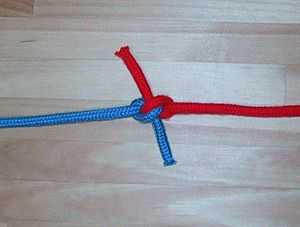Hunter's bend
| Hunter's bend | |
|---|---|
 | |
| Names | Hunter's bend, Rigger's bend |
| Category | Bend |
| Related | Alpine butterfly bend, Zeppelin bend, Ashley's bend |
| ABoK | #1425A |
The Hunter's bend (or rigger's bend) is a knot used to join two lines. It consists of interlocking overhand knots, and can jam under moderate strain. It is topologically similar to the Zeppelin bend.
History

In October 1978 an article in the The Times presented it as a newly invented knot credited to Dr. Edward Hunter.[1] He had used it for years to tie broken shoelaces before discovering its originality through a friend in the 1970s. When it appeared on the front page, it led to much publicity for the knot and also to the formation of the International Guild of Knot Tyers.
It was later pointed out by Amory Bloch Lovins that the knot had already been presented in Knots for Mountaineering by Phil D. Smith in the 1950s.[2] The tying of the bend was described as a modification to the alpine butterfly bend.[3] Smith had devised the knot in 1943 while working on the San Francisco waterfront and had called it simply a "rigger's bend".[4]
The Hunter's bend was added to The Ashley Book of Knots in 1979 as entry #1425A.[5]
See also
References
- ↑ Howard, Philip (6 Oct 1978) "Doctor ties up his claim to fame", in The Times (includes information from Inspector Geoffrey Budworth)
- ↑ Budworth, Geoffrey (1985) [1983], The Knot Book, New York: Sterling Publishing, p. 127
- ↑ Smith, Phil D. (1955) [1953]. Knots for Mountaineering, Camping, Utility, Rescue, etc. Twentynine Palms, CA: Desert Trail.
- ↑ Budworth, Geoffrey (2002), Much Ado About Knotting: A History of the International Guild of Knot Tyers (2nd ed.), Needham Market, UK: Gipping Press, p. 5, ISBN 0-9515506-5-9
- ↑ Ashley, Clifford W. (1993) [1944], The Ashley Book of Knots, New York: Doubleday, pp. 260–261, ISBN 0-385-04025-3